
With a new year just begun, it might be time to start thinking about rebalancing the gold holdings in your portfolio. That includes bullion, jewelry, gold stocks and well-managed gold exchange-traded funds (ETFs). Because 2017 was such a strong year for stocks—they advanced close to 20 percent, as measured by the S&P 500 Index—it’s likely that most investors will want to rebalance their gold exposure as we head into 2018.
Some investors might wonder why they need gold in their portfolios right now. The stock market is still chugging along, and the just-passed tax reform bill is expected to help ratchet up share prices even more.
It’s important to remember that the precious metal has historically shared a low-to-negative correlation with equities. For the past 30 years, the average correlation between the LBMA gold price and the S&P 500 Index has been negative 0.06. In August 2016, the correlation between the two hit negative 0.63, the lowest ever recorded.
This makes the metal, we believe, an appealing diversifier in the event of a correction in the capital markets.
Need more reasons to add to your gold exposure? Below are 10 charts that show why the yellow metal is undervalued right now:
1. The gold price has crushed the market so far this century.
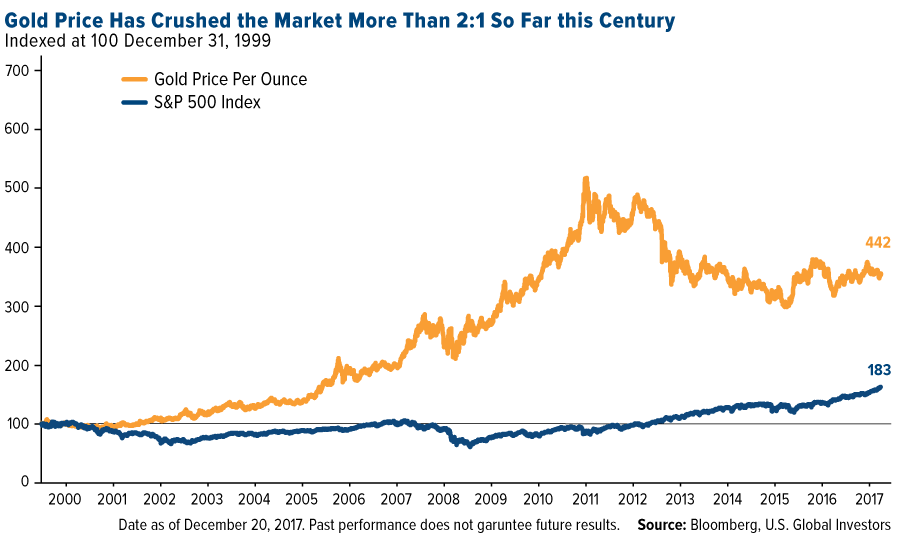
Believe it or not, since 2000, the gold price has beaten the S&P 500 Index, which has undergone two 40 percent corrections so far this century.
2. Compared to stocks, gold looks like a bargain.
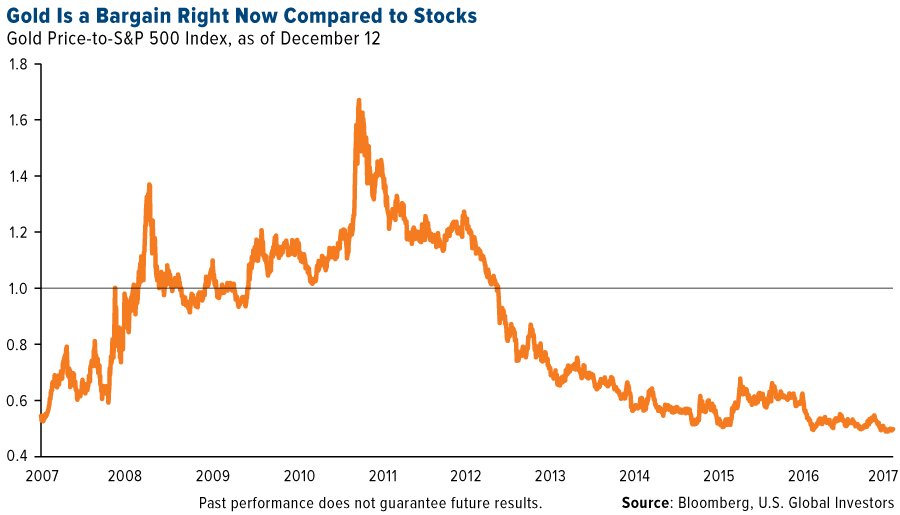
As of last month, the gold-to-S&P 500 ratio was at its lowest point in 10 years. What that means is, compared to stocks, gold is incredibly undervalued on a historical basis. For mean reversion to occur, either the gold price needs to appreciate or share prices need to fall. Either way, consider this a once-in-a-decade opportunity.
3. Exploration budgets keep getting slashed.
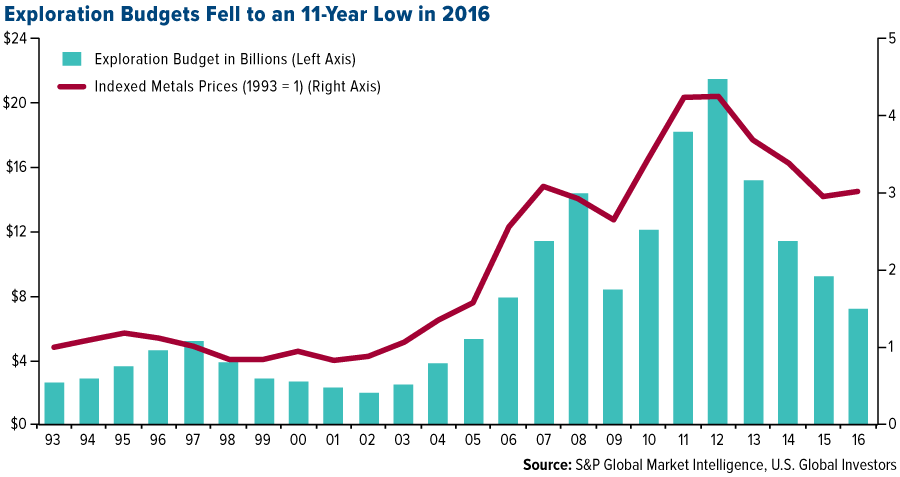
One of the reasons why gold is so highly valued is for its scarcity. There’s a possibility it could get even scarcer as explorers continue to trim exploration budgets and uncover fewer and fewer large deposits. The time between initial discovery and day one of production is also expanding. This has led many experts in the field to wonder if we’ve finally reached “peak gold.”
4. Gold stocks could be just getting started.
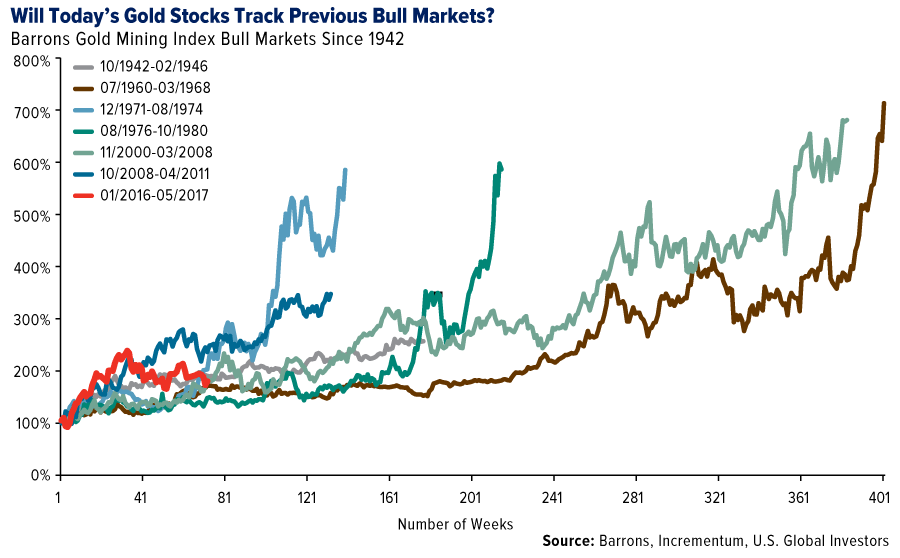
2016 marked a turnaround in gold prices and gold stocks, and according to analysts at Incrementum Capital Partners, a Swiss financial management firm, they’re just getting warmed up. When charted against past gold bull markets, the present one looks as if it still has a lot of room to run.
5. Is too much money going into equities?
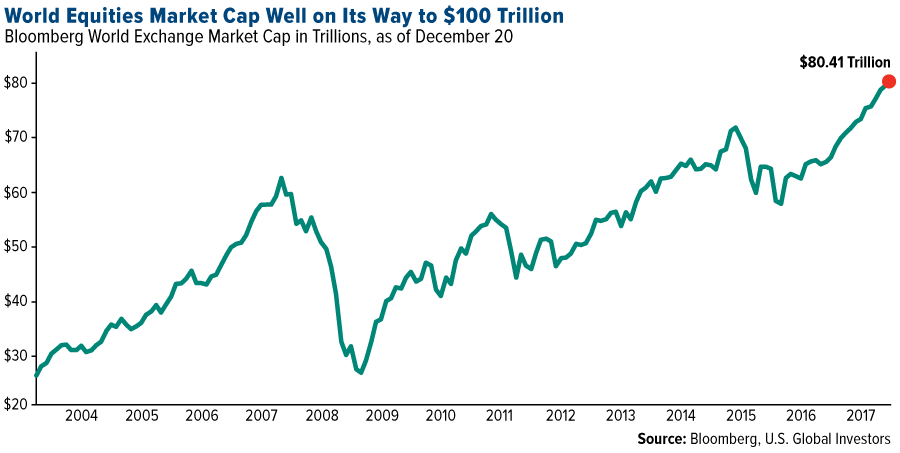
More than $80 trillion sits in global equities right now, a monumental sum that’s likely to surge even more as we venture further into the bull market. (Here, total market cap refers to the market value of all companies’ shares.) Some worry this is a ticking time bomb just waiting to go off. Another correction similar to the one 10 years ago could conceivably wipe out a lot of money around the world, and it’s then that the investment case for gold would become strongest.
6. Higher debt could mean higher gold prices.
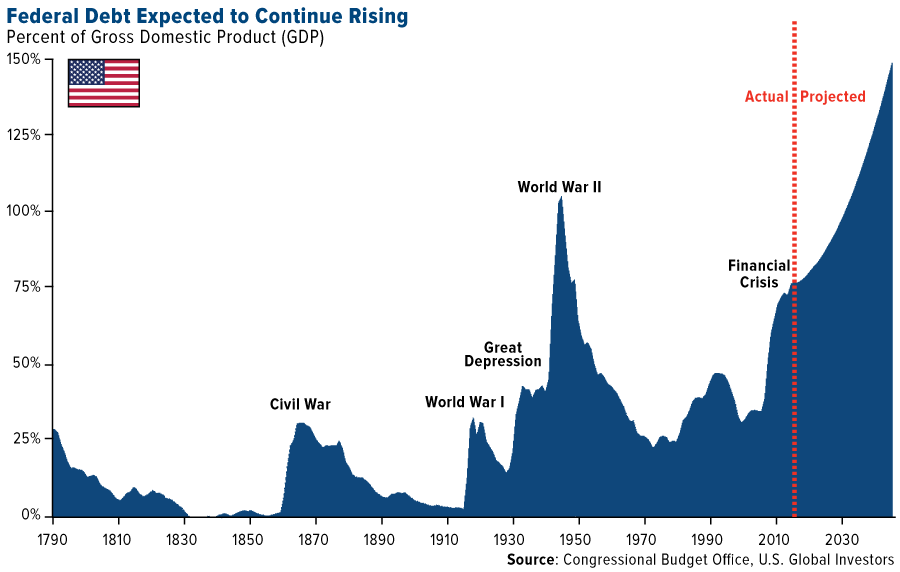
The yellow metal has historically tracked global debt, which stood at $217 trillion as of the first quarter of last year. Looking just at the U.S., debt is expected to continue on an upward trend, driven not just by new, and largely unfunded, spending but also underlying interest. By most estimates, President Donald Trump’s historic tax cuts, although welcome, will contribute to even higher debt as a percent of gross domestic product (GDP).
7. The Fed’s about to take away the punch bowl.
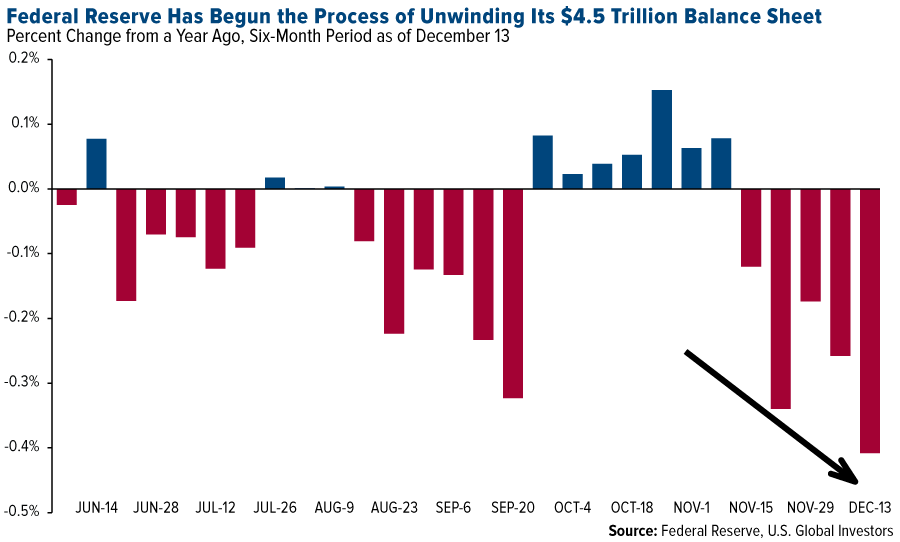
“My opinion is that business cycles don’t just end accidentally. They end by the Fed. If the Fed tightens enough to induce a recession, that’s the end of the business cycle.” That’s according to MKM Partners’ chief economist Mike Darda, who was referring to the Federal Reserve’s efforts to unwind its $4.5 trillion balance sheet after it bought vast quantities of government bonds and mortgage-backed securities to mitigate the effects of the Great Recession. There’s definitely a huge amount of risk here: Five of the previous six times the Fed has similarly reduced its balance sheet, between 1921 and 2000, ended in recession.
8. Rate hike cycles have rarely ended well.
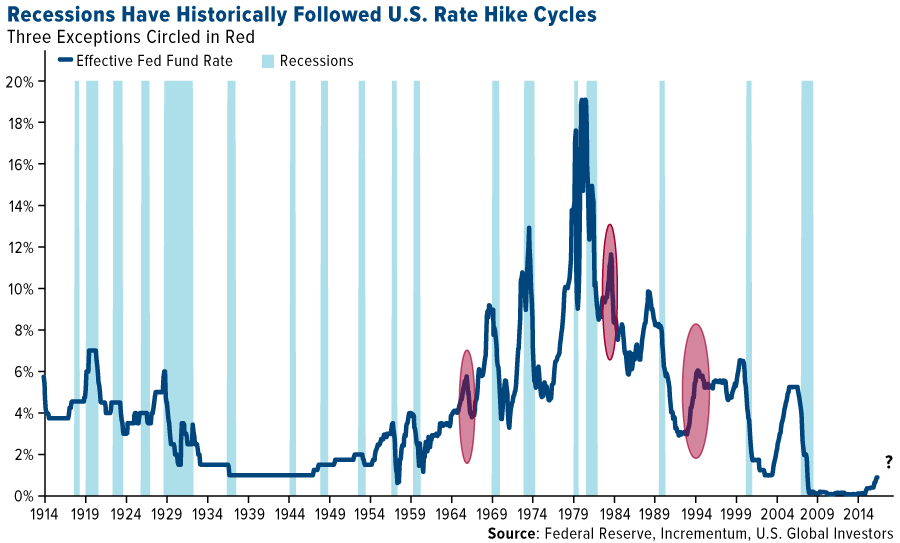
Rate hike cycles also have a mixed record. According to Incrementum research, only three such cycles in the past 100 years have not ended in a recession. Obviously, there’s no guarantee that this particular round of tightening will have the same outcome, but if you recognize the risk here, it might be prudent to have as much as 10 percent of your wealth in gold bullion and gold stocks.
9. Many global bonds are delivering negative returns right now.
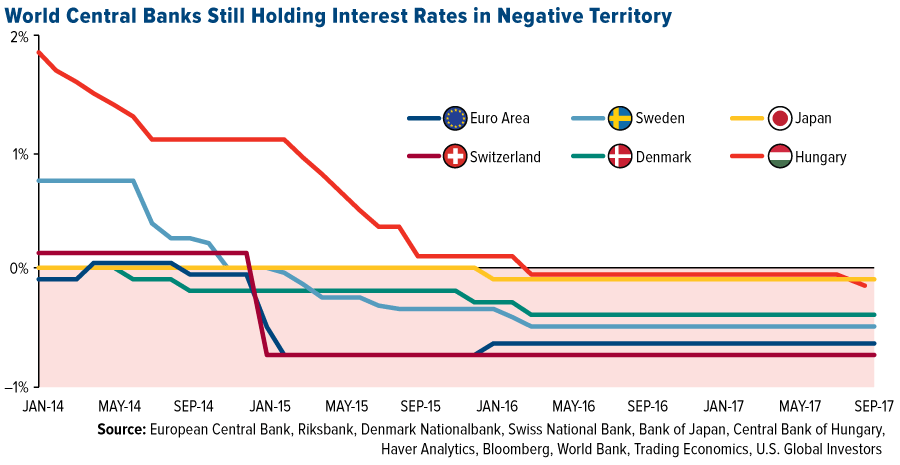
As of May of last year, nearly $10 trillion of bonds around the world were guaranteed to cost investors money, as more and more central banks instituted negative interest rate policies (NIRPs) to spur consumer spending. Instead, it encouraged many savers to yank their cash out of banks and convert it into gold. That’s precisely what households in Germany did, and by 2016, the European country became the world’s biggest investor in the yellow metal.
10. The Love Trade is still driving gold demand.
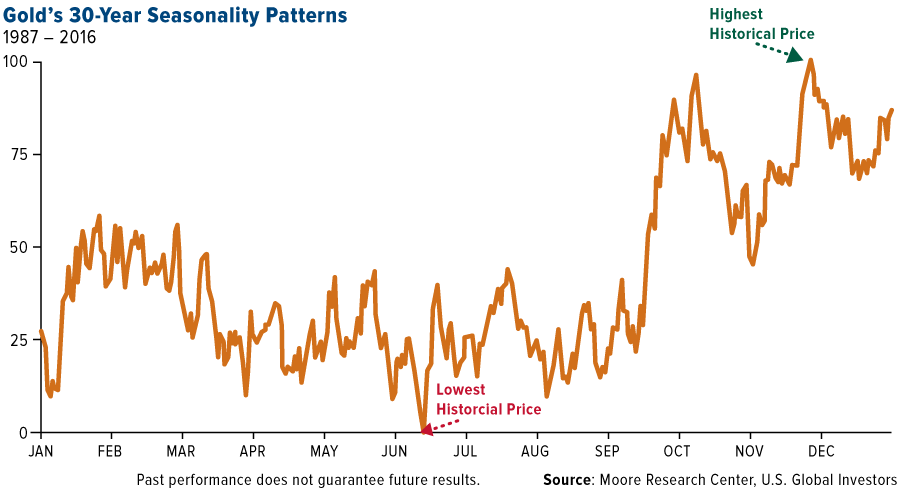
The chart above, based on data provided by Moore Research, shows gold’s 30-year seasonal trading pattern. Although it’s changed over the past few years, the pattern reflects the Love Trade in practice. According to the data, the gold price has rallied early in the year as we approached the Chinese New Year, then dipped in the summer. After that, it surged on massive gold-buying in India during Diwali, in late October and early November. Finally, it ended the year at its highest point during the Indian wedding season, when demand is high. The pattern wasn’t always observed exactly as described, but it happened frequently enough for us to make educated, informed decisions on when to trade the precious metal.
Interested in learning how you can gain exposure to the gold industry in 2018? Find out by clicking here!
All opinions expressed and data provided are subject to change without notice. Some of these opinions may not be appropriate to every investor.
The LBMA Gold Price is the global benchmark prices for unallocated gold delivered in London. The auctions are run at 10:30 am and 3:00 pm London time. The final auction prices are published to the market as the LBMA Gold Price AM and LBMA Gold Price PM.
The Standard & Poor’s 500, often abbreviated as the S&P 500, or just the S&P, is an American stock market index based on the market capitalizations of 500 large companies having common stock listed on the NYSE or NASDAQ. The S&P 500 index components and their weightings are determined by S&P Dow Jones Indices.
The Barron’s Gold Mining Index (BGMI) consists of publicly traded companies involved primarily in the mining for gold.
Correlation, in the finance and investment industries, is a statistic that measures the degree to which two securities move in relation to each other. Correlations are used in advanced portfolio management. Correlation is computed into what is known as the correlation coefficient, which has value that must fall between -1 and 1.
Mean reversion is the theory suggesting that prices and returns eventually move back toward the mean or average. This mean or average can be the historical average of the price or return or another relevant average such as the growth in the economy or the average return of an industry.
Diversification does not assure a profit, nor does it protect against a loss in a declining market.
